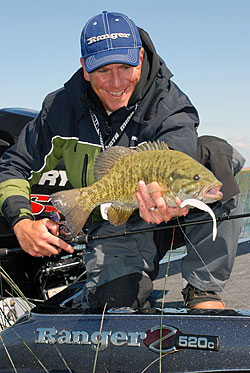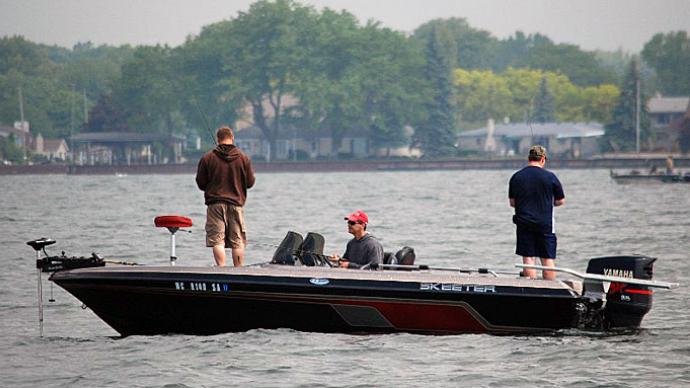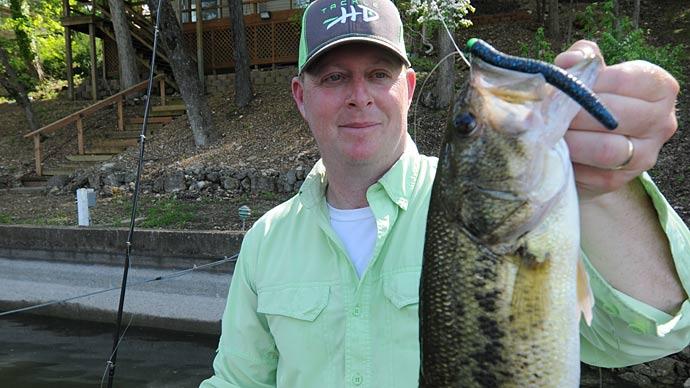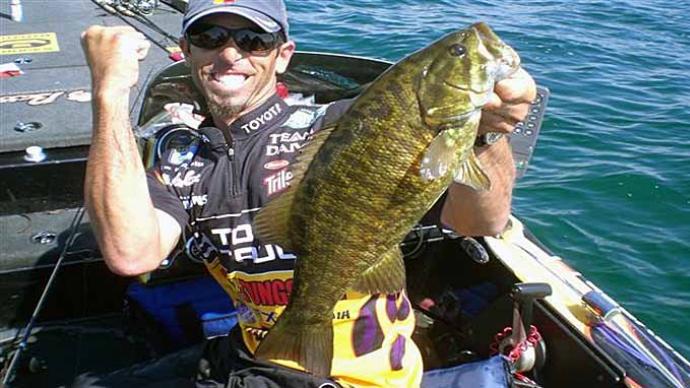
Big bass are no fluke unless you’re using one. Flukes, or soft jerkbaits, are one of the most versatile plastics ever made. More adaptable than the classic Senko, flukes can be fished like a typical jerkbait with erratic twitches to simulate a fleeing baitfish, used as a finesse bait on a drop-shot rig, rigged Texas- or Carolina-style, or plunked on a bed and jiggled like a shaky worm. The options are endless.
“A fluke is wider than a Senko worm,” shared bass pro Joe Balog of Millennium Promotions. “And the fluke has way more action. A Senko is a stick worm. Senkos are super salty and very buoyant. They have a built-in live-action all their own. Because of that, I rarely rig them whacky style. Flukes, you need to work more. One of the best techniques is to snap it like a jerkbait because basically, that’s what they are – a plastic jerkbait.”
“I like to snap them and twitch them to look like a fleeing baitfish, fish it near the surface, work it quickly, even have it break the surface occasionally like a baitfish trying to escape and jumping out of the water.” This can be a great technique when schooling bass are busting shad in open water, too.
“A fluke is perfect for working a single piece of cover like a single tree, under a dock, next to a log or stump or on a bed,” Balog said. “I use it as a finesse bait. I use it basically as a shallow water tool, but you can fish it deep if you want or on a drop shot. ”

Flukes come in a wide variety of colors and sizes. “You can buy flukes from 4 to 7 inches, but I only use the 5-inch model. It’s a nice size and easy to cast. If I was fishing a place I knew had monster bass, I might consider something bigger.”
Zoom Bait Company, Inc. (zoombait.com) manufacturers some of the most popular flukes. Known for their softness, Zoom flukes are salt-impregnated to convince bass to eat. Available in various shapes and sizes, from the Tiny Fluke to the Magnum Super Fluke and Fluke Tail Goby imitations, the 5-inch Super Fluke is the most popular with anglers. It comes in various colors covering the gambit, from black to pearlescent. Zoom also makes a Fluke Stick that’s a cross between a fluke and a Senko.
“When using a fluke, I’m trying to imitate baitfish,” Balog commented. “I’ll generally stick with pearlescent, white or shad or watermelon if I’m trying to imitate bluegills.” Fluke fishing does not require any specialized tackle. Balog uses a 7-1/2-foot medium action Diawa Zillion spinning outfit with 12-pound fluorocarbon. Bait-casting gear and braid can be used, but the bass pro prefers spinning tackle with fluorocarbon when fishing crystal clear water.
Using a fluke as a soft jerkbait isn’t the only way to fish the lure. A fluke makes for a tremendous drop-shot lure that can be fished tantalizingly and methodically to induct reluctant bass. The rig works exceptionally well when combing flats adjacent to deeper water where bass move up to feed.
Spawning bass are known to be incredibly selective. They aren’t feeding when on the beds, and their primary concern is defending their territory. A fluke works well with a small, pegged bullet weight rigged Texas-style. Drop it on a bed and jig/hop it until the bass can’t stand it anymore. Because a fluke feels so life-like, a bass is also likely to hold onto the bait until you can set the hook. While pearl and white might be best for imitating shad, this is one time when a darker color, like watermelon with flakes and a tinge of purple, might be better for mimicking nest-raiding bluegills and sunfish.

While the twitch, twitch, twitch retrieve like a jerkbait can work wonders in the shallows, there are times when flukes can be equally productive over deep water when bass are pushing shad schools to the surface. The panic retrieve can also be a great search tool targeting main lake points that lead from spawning grounds to deep water as bass transition to summer patterns.
Don’t rely on one presentation when using flukes. Vary the cadence of your retrieve. A pop, pop, pop presentation usually produces well. However, do not forget to use a pause and swim, an erratic skipping presentation, or do nothing at all like when fishing a Senko.
Rigging a fluke is simple. Insert the point of a 4/0 or 5/0 wide gap, wide bend hook into the nose of the lure about ¼ inch and out, turn the hook over and insert it in the slot of bait and out just under the top edge of the bait. Numerous videos on the Internet show you how to do this. You can experiment by inserting the hook slightly off-center, either higher or lower in the lure, which will cause the bait to rise or dive when manipulated.
Flukes fish best when they’re straight. A bent fluke will spin and twist your line and not dart properly. Often, flukes are bunched into one corner of the packaging, which will cause them to be bent. Don’t use them this way. Instead, bring a pan of water to a boil and dip the fluke in the boiling water for no more than 15 to 20 seconds. After dipping in the water, the fluke should be straight again. Lay it on a towel to cool. Take care to lay flukes flat in the package and store them upright in your tackle box or a tackle bag.
A little customization will sometimes give your fluke the subtle zing it needs. You can add stripes or bars with markers or use a dip to accent the tail or head to help bass zero in.
Fishing flukes isn’t rocket science. You can do just about anything and catch bass.




